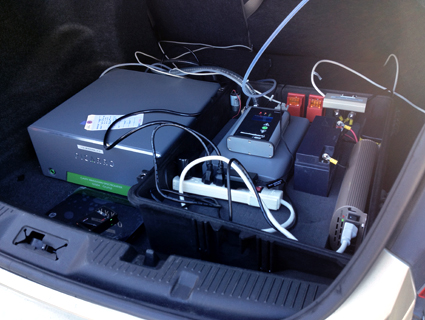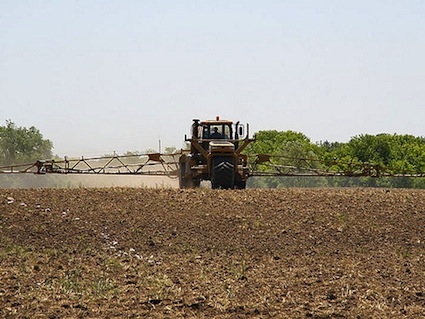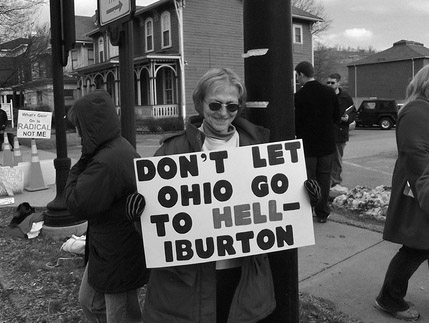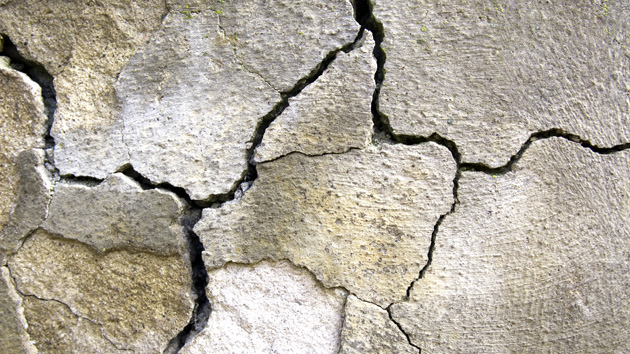
<a href="http://www.shutterstock.com/pic.mhtml?id=10386502">vladm</a>/Shutterstock
At exactly 10:53 p.m. on Saturday, November 5, 2011, Joe and Mary Reneau were in the bedroom of their whitewashed and brick-trimmed home, a two-story rambler Mary’s dad custom-built 43 years ago. Their property encompasses 440 acres of rolling grasslands in Prague, Oklahoma (population 2,400), located 50 miles east of Oklahoma City. When I arrive at their ranch almost a year later on a bright fall morning, Joe is wearing a short-sleeve shirt and jeans held up by navy blue suspenders, and is wedged into a metal chair on his front stoop sipping black coffee from a heavy mug. His German shepherd, Shotzie, is curled at his feet. Joe greets me with a crushing handshake—he is 200 pounds, silver-haired and 6 feet tall, with thick forearms and meaty hands—and invites me inside. He served in Vietnam, did two tours totaling nine years with the Defense Intelligence Agency, and then, in 1984, retired a lieutenant colonel from the US Army to sell real estate and raise cattle. Today, the livestock are gone and Joe calls himself “semiretired” because “we still cut hay in the summers.”
On that night in November, just as he and Mary were about to slip into bed, there was “a horrendous bang, like an airliner crashing in our backyard,” Joe recalls. Next came 60 seconds of seismic terror. “The dust was flying and we were hanging onto the bed watching the walls go back and forth.” Joe demonstrates by hunching over and gripping the mattress in their bedroom. He points to the bathroom. “The mirror in the vanity exploded as if somebody blew it out with a shotgun.” When the shaking stopped, Joe surveyed the damage. “Every corner of the house was fractured,” he says. The foundation had sunk two inches. But most frightening was what Joe discovered in the living room: “Our 28-foot-tall freestanding chimney had come through the roof.” It had showered jagged debris onto a brown leather sofa positioned in front of their flat-screen TV. Joe shows me the spot. “It’s Mary’s favorite perch. Had she been here…” He chokes up.
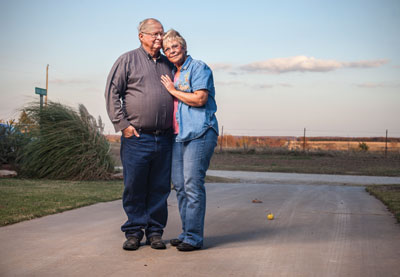
The earthquake registered a magnitude 5.7*—the largest ever recorded in Oklahoma—with its epicenter less than two miles from the Reneaus’ house, which took six months to rebuild. It injured two people, destroyed 14 homes, toppled headstones, closed schools, and was felt in 17 states. It was preceded by a 4.7 foreshock the morning prior and followed by a 4.7 aftershock.
The quake baffled seismologists. The only possible culprit was the Wilzetta Fault, a 320-million-year-old rift lurking between Prague and nearby Meeker. “But the Wilzetta was a dead fault that nobody ever worried about,” says Katie Keranen, an assistant professor of geophysics at the University of Oklahoma. We’re driving in her red SUV, just south of the Reneaus’ property, when she stops to point out where the quake tore open a footwide fissure across State Highway 62. The United States Geological Survey (USGS) maintains a database of seismically risky areas. Its assessment of the Wilzetta Fault, Keranen notes, was “zero probability of expected ground motion. This fault is like an extinct volcano. It should never have been active.”
When the Wilzetta mysteriously and violently awakened, Keranen wanted to know why. So she partnered with scientists from the USGS and Columbia University’s Lamont-Doherty Earth Observatory. The morning after the initial foreshock, Keranen’s team scrambled to install three seismometers around Prague. They did so in time to capture the quake system in unprecedented detail. She says, “We got this beautiful image of the fault plane.” Within a week, her team and other scientists had placed a total of 25 devices around the fault zone. One is buried in the Reneaus’ backyard. Now, having completed a yearlong study (just published in the journal Geology), Keranen’s research indicates the Oklahoma earthquakes were likely attributable to underground injection of wastewater derived from “dewatering,” separating crude oil from the soupy brine reaped through a drilling technique that allows previously inaccessible oil to be pumped up. “Pretty much everybody who looks at our data accepts that these events were likely caused by injection,” Keranen concludes.
“We still feel tremors weekly,” complains Joe Reneau. “They rattle our windows.” The couple hasn’t bothered to rehang family photos in their living room. Instead, the framed snapshots are stacked in tidy piles on a coffee table.
Such seismic activity isn’t normal here. Between 1972 and 2008, the USGS recorded just a few earthquakes a year in Oklahoma. In 2008, there were more than a dozen; nearly 50 occurred in 2009. In 2010, the number exploded to more than 1,000. These so-called “earthquake swarms” are occurring in other places where the ground is not supposed to move. There have been abrupt upticks in both the size and frequency of quakes in Arkansas, Colorado, Ohio, and Texas. Scientists investigating these anomalies are coming to the same conclusion: The quakes are linked to injection wells. Into most of them goes wastewater from hydraulic fracking, while some, as those in Prague, are filled with leftover fluid from dewatering operations.
The impact of fossil fuels is no secret, but until now the short list of dirty energy’s villains never included water. Together, oil and gas extraction and production generate about 878 billion gallons of wastewater annually, roughly what tumbles over Niagara Falls every two weeks. More than a third is injected back into disposal wells. With natural gas production on the rise—it has jumped 26 percent since 2007, chiefly because fracking now makes it economically viable to pursue gas trapped in shale deposits—and unconventional practices such as dewatering ramping up domestic oil development, the wastewater deluge is expected to get worse. Operators are injecting more water than ever into drilling wells, while boring new wells to accommodate the overflow. Yet nobody really knows how all this water will impact faults, or just how big an earthquake it could spawn. In the West, small quakes don’t often cause much damage because of stricter seismic regulations but also because the underground formations—buckled, with younger rock—absorb all but the biggest events. Induced quakes, however, are happening primarily in flatter states, amid more rigid rock, making them more destructive—a stone makes a bigger splash when it’s hurled into a glassy pond than a river of raging whitewater.
For its part, industry is doing its best to avoid discussing the issue publicly, even as its leading professional guild, the Society of Petroleum Engineers, recognized the matter was serious enough to call its first-ever meeting devoted to “injection induced seismicity.” Held in September, the SPE’s 115-member workshop sought to “better understand and mitigate potential risks.” When I reached out to SPE coordinator Amy Chao, she told me, “I appreciate your interest but press is not allowed to attend in any fashion.” My requests to speak with geophysicists at leading oil and gas companies implicated in injection-induced earthquakes were also ignored or denied. I did manage to speak with Jean Antonides, vice president of exploration for New Dominion, which operates one of the wells near the Wilzetta Fault. He informed me that people claiming to know the true source of the Oklahoma quakes are “either lying to your face or they’re idiots.”
Nonetheless, there’s growing concern among state officials. After a spate of quakes linked to injection wells shook northern Arkansas, the state’s oil and gas commission declared a moratorium on underground wastewater disposal activities within a 1,000-square-mile area encompassing the towns of Guy and Greenbrier and required seismic-risk studies in the greater Fayetteville Shale area. Affected residents filed a class-action lawsuit against Chesapeake Energy and BHP Billiton Petroleum—the first time anyone has sued oil and gas companies for causing an earthquake. After an injection well was linked to quakes in Youngstown, Ohio, Gov. John Kasich issued an executive order requiring operators to conduct seismic studies before the state will issue well permits. So far, Ohio is alone in this regard; no other state—or the federal government—requires any type of seismic-risk assessment for all of its injection wells. And that worries scientists: “Nobody is talking to one another about this,” says William Ellsworth, a prominent USGS geophysicist who’s published more than 100 papers on earthquakes. Among other mishaps, Ellsworth worries that a well could pierce an unknown fault “five miles from a nuclear power plant.”
The EPA classifies and regulates underground injection wells—some 700,000 and counting—based on what goes into them. There are six categories. Class VI wells sequester carbon dioxide; Class V wells store nonhazardous fluids; nuclear waste is stashed in Class IV wells; Class III wells are used in mining salt, uranium, copper, and sulfur; industrial chemicals get stored in Class I wells. Wastewater from oil and gas operations is discharged—typically by injecting it under pressure—into Class II wells.
There are at least 155,000 Class II wells in the United States. Of these about 80 percent are involved in recovering hydrocarbons, predominantly through slick-water hydrofracking, a technique developed by Halliburton. Fracking fluid—water blended with lubricants, thickeners, disinfectants, and other compounds—is pumped into well bores at extremely high pressures. Eventually, the fluid reverses course and—along with millions of gallons of salt water that resides underground—ascends to the surface. The “flowback,” now laden with natural gas, is collected, the gas is extracted, and the residual fluid is pumped into disposal wells. There are roughly 40,000 of these, and they can be up to 13,000 feet deep.
The extraction process itself doesn’t generally produce earthquakes. This is because of something known as pore pressure, a measurement of how much stress a fluid exerts into the “pores” of surrounding rock. The whole aim of fracking is to rapidly increase pore pressure just long enough to cleave fissures into sediment and free trapped gas, after which time pore pressure equalizes, easing the subterranean stress. Only rarely is pore pressure high enough in a fracking well to cause an earthquake that can be felt at the surface.
But while fracking wells are intended to withstand high pore pressure, wastewater disposal wells are not. When pore pressure spikes in disposal wells, it can move rock. Disposal wells are drilled into vast, permeable formations—think giant sponges—where there’s plenty of space for water to spread out. But because water is heavy, the more of it that is sluiced into a well, the more it weighs on the rock below. And as Scott Ausbrooks, a geologist with the Arkansas Geological Survey, points out, “Water does not like to be squeezed.” Eventually it finds an escape route, “just like a room of people. The more you put in, the more crowded it gets, and at some point, people are going to start being pushed out the doors.”
Animated GIF: fracked Up?
Drillers inject high-pressure fluids into a hydraulic fracturing well, making slight fissures in the shale that release natural gas. The wastewater that flows back up with the gas is then transported to disposal wells, where it is injected deep into porous rock. Scientists now believe that the pressure and lubrication of that wastewater can cause faults to slip and unleash an earthquake.
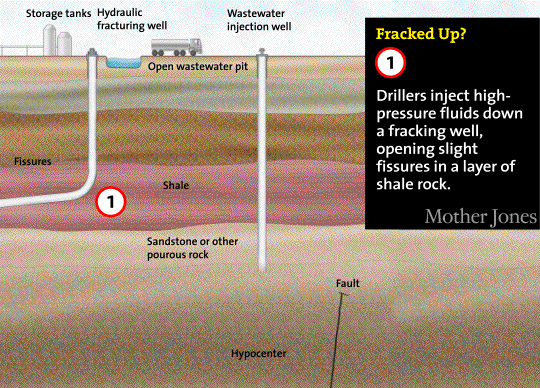
Illustration: Leanne Kroll. Animation: Brett Brownell
With the oil and gas boom generating record amounts of wastewater, these rooms are getting increasingly jam-packed. Exactly how much? The EPA tracks volumes but wouldn’t provide them; agency officials declined numerous requests for interviews. Companies are also pumping into denser rock, or into deeper formations that are inherently unstable. “There’s much more injection going on today where there wasn’t injection before,” says Cliff Frohlich, associate director of the Institute for Geophysics at the University of Texas-Austin, who recently identified a cluster of wells at the Dallas/Fort Worth International Airport as the likely culprit for nearby earthquakes.
Too much wastewater in a disposal well forces liquid downward and outward, he adds. It can meander for months, creeping into unknown faults and prying the rock apart just enough to release pent-up energy. Frohlich describes this as the “air hockey” effect. A puck on an air hockey table won’t move even if the table is tilted upward a few degrees. “It would just sit there,” he says. “But when you turn on the air, it reduces the friction and the puck will slide. There are faults most everywhere. Most of them are stuck, because rock on rock is pretty sticky. But if you pump a fluid in there to reduce the friction, they can slip.”
*It should be noted that the United States Geological Survey used two different techniques to estimate the earthquake magnitude at 5.6. The Global Centroid-Moment-Tensor Project at Lamont-Doherty Earth Observatory of Columbia University used different methods to measure it at 5.7. As Justin Rubinstein of the USGS told us, this type of variance is not unusual, and the measurements are considered consistent.
That’s exactly what happened in northern Arkansas, where, according to state geologist Ausbrooks, water from several injection wells pushed apart the two sides of a fault, “allowing it to slip and start popping off the earthquakes”—thousands of them. Ausbrooks, along with Stephen Horton, a University of Memphis seismologist, identified the source: a previously unknown seven-mile-long fault that hadn’t budged in modern times. Though not huge, the fault is still long enough to generate a magnitude-6.0 earthquake. (In 1993, when an equal-size temblor hit Klamath Falls, Oregon, it killed two people and caused $7.3 million worth of damage—in a rural area.)
While the largest faults in the United States are documented and mapped—the San Andreas, New Madrid, Cascadia, and dozens of others—”there are faults everywhere, and some are too small to be seen,” explains Mark Zoback, a professor of geophysics at Stanford University who was on the National Academy of Engineering committee that investigated the Deepwater Horizon oil spill. “A fault can be missed that could produce an earthquake large enough to cause some moderate damage.”
Scarier still is that any fault, no matter how minuscule, can instigate the domino effect scientists have observed during injection-induced earthquakes. “The scenario we worry about is one earthquake spawning another,” says the USGS’s Ellsworth. This phenomenon was evident in Oklahoma, Keranen says, where “we had one fault-plane go, a second one, and then a third one. They ruptured in sequence.” The first tremor in Prague sprang from a minor fault that collided with a larger fault, sparking the quake that trashed Joe and Mary Reneau’s home, along with a dozen others.
How far from the site of an injection well could a quake occur? Scientists aren’t sure. In Arkansas, along the fault discovered by Ausbrooks, tremors emanated nearly 10 miles. Had those quakes collided with another fault, the shaking might have extended much farther. “Once it starts moving, it’s like a chain reaction,” notes Ausbrooks.
All these factors were in play in Youngstown, where D&L Energy Group conducted an experiment, burrowing 200 feet into solid rock known as the Precambrian layer, according to Heidi Hetzel-Evans, spokeswoman for the Ohio Department of Natural Resources. Tremors began three months after wastewater entered the well. The strongest, a 4.0, struck on New Year’s Eve. Wastewater had seeped nearly 2,500 feet beyond the bottom of the borehole into an unknown fault. “There will be no more drilling into Precambrian rock in Ohio,” Hetzel-Evans dryly tells me.
John Armbruster, a seismologist at Lamont-Doherty who was among those summoned to Youngstown, told me, “This well caused these earthquakes. There were no felt earthquakes in Youngstown in 100 years.” Within a year of the well opening, there were “12 felt earthquakes. After the well was shut down, the number decreased dramatically. You’d need Powerball odds for that to be a coincidence.”
There is no shortage of evidence. After quakes struck near Trinidad, Colorado, in 2011, the USGS set up a monitoring network. “A magnitude-5.3 earthquake occurred within two kilometers of two high-volume injection wells,” says Justin Rubinstein, who is part of a new USGS project to study human-induced seismicity. “These earthquakes were caused by fluid injection.” Ditto in Dallas; as UT-Austin’s Frohlich points out, “These earthquakes could have been anywhere. They weren’t. Virtually all of them were near injection wells.”
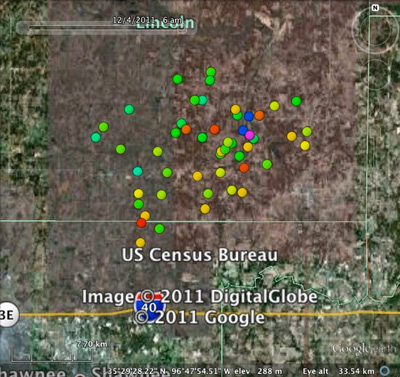
Ellsworth, who peer-reviewed Keranen’s study, has researched earthquakes for more than 40 years and is a recipient of the Department of the Interior’s highest honor for his contributions to seismology. He studied geophysics at Stanford, earned his doctorate from MIT, and is the former president of the Seismological Society of America. When I asked him if there is any doubt among his colleagues about what produced the quakes in Arkansas, Colorado, Ohio, Oklahoma, and Texas, he replied, “Injection of wastewater into Class II wells has induced earthquakes, including the ones you cite.” Rubinstein agrees: “In my opinion, it’s pretty clear in all of these cases—Youngstown, Arkansas, DFW, Trinidad, and Oklahoma—that injection wells were the cause.”
Does industry concur? Jim Gipson, director of media relations for Chesapeake Energy, operator of the wells under DFW airport and a now-closed well near Greenbrier, Arkansas, declined my request for an interview. Hal Macartney, geoscience adviser for Pioneer Natural Resources, which owns some of the wells implicated in the Colorado quakes, dodged my calls and emails for three weeks. Even those not implicated directly with quake-causing wells are staying silent. Hydrofracking pioneer Norman Warpinski, who works for Halliburton, refused comment. Geophysicist Mark Houston and managing partner Steve Sadoskas, at oilfield-services provider Baker Hughes, wouldn’t talk. Julie Shemeta, founder of MEQ Geo, a firm that does seismic consulting for oil and gas exploration, said she was too busy for a 15-minute phone call even though I offered her a two-month window to schedule it.
I’m not the only one getting rebuffed. There is “a lack of companies cooperating with scientists,” complains seismologist Armbruster. “I was naive and thought companies would work with us. But they are stonewalling us, saying they don’t believe they are causing the quakes.” Admitting guilt could draw lawsuits and lead to new regulation. So it’s no surprise, says Rubinstein, “that industry is going to keep data close to their chest.” When I ask Jean Antonides, New Dominion’s VP of exploration, why the industry is sequestering itself from public inquiry, he replies, “Nobody wants to be the face of this thing.” Plenty of misdeeds are pinned on oil and gas companies; none wants to add earthquakes to the list.
The USGS’s Ellsworth tells me that some operators track seismic data near well sites but won’t share it, and so far there is no state or national regulatory requirement to do so. And the “Halliburton Loophole” written into the 2005 energy bill at the behest of then-Vice President (and former Halliburton CEO) Dick Cheney excludes hydrofrackers from certain EPA regulations, among them provisions related to “the underground injection of fluids…related to oil, gas, or geothermal production activities.” Upshot: “It’s an age where information has exploded, but this is an area where we’re still working in punch cards,” Ellsworth says.
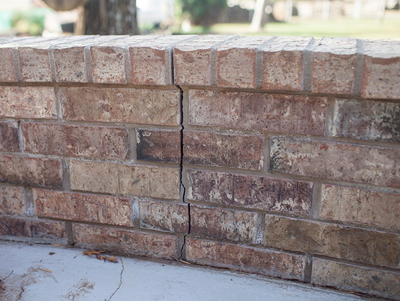
Just knowing the daily volumes of water being pumped into a well would yield critical clues. “There is a correlation that shows the largest earthquakes tend to be associated with the largest volume wells,” adds Ellsworth. Ideally, the USGS would get real-time data. But operators are only required to track monthly volumes, and those tallies are often delayed six months or more. By then, it’s too late. Rubinstein wants “industry to actually give us hourly or daily injection pressures and volume, so we can model where the fluids are going and predict how the stress evolves over time…and be able to come up with some probabilistic sense of how likely you are to generate an earthquake.”
As for Keranen’s explosive research on the Wilzetta Fault, New Dominion’s Antonides is recruiting his own scientists to produce a report challenging it. Meanwhile, he has his own theories. “The traffic driving across the freeway could have caused it,” he says, adding that another “trigger point” is the two large aquifers that bracket the fault. Drought has reduced their water levels, “removing a lot of the weight” and allowing the ground underneath to “rebound” and perhaps release energy in a pent-up fault. “All this stuff is tied together—the aquifers, plus trucks driving across the freeway, plus water disposal, plus 50-story buildings—the whole system of man.” (This hypothesis has some basis in reality. Scientists in Taiwan fear that the weight of a skyscraper unhinged faults underlying Taipei. Though no such structure, it must be said, is found within 50 miles of Prague, Oklahoma.)
Nine days after the New Year’s Eve quake in Youngstown, D&L Energy Group issued a statement that said, “There has been no conclusive link established between our well and the earthquakes. Proximity alone does not prove causation.” In March 2012, state officials published a report explicitly detailing the connection, noting that the recent quakes were “distinct from previous seismic activity in the region because of their proximity to a Class II deep injection well. In fact, all of the events were clustered less than a mile around the well.” But D&L still questions the new findings—even though the quakes petered out soon after the company voluntarily shut down its well.
Ausbrooks and Horton partnered for nearly a year to research the Arkansas earthquakes, driving around the state to install seismometers and collect data. And yet when it came time to publish the results in a leading scholarly journal, Seismological Research Letters, Arkansas Gov. Mike Beebe forced Ausbrooks to remove his name as coauthor. Ausbrooks’ boss at the Arkansas Geological Survey is Bekki White, who did two decades of consulting for the petroleum industry prior to her current post. “Ms. White conferred with our office,” Matt DeCample, a Beebe spokesman, tells me. “We felt that putting the state and/or Mr. Ausbrooks as a coauthor would represent additional academic credentials beyond their usual scope of work. The survey is in the business of data collection, not interpreting that data and reaching conclusions.” When I ask Ausbrooks for a better explanation, he laughs nervously. “Oh, let’s just say, I want to say, but I can’t. I’ll just put it this way: There’s money and politics involved.” (The state collects $14 million in property taxes from Chesapeake Energy alone.)

Fracking is an area where conflicts of interest seem particularly apt to emerge. In December, UT-Austin was forced to retract a much-ballyhooed study showing that fracking didn’t pollute groundwater after Bloomberg News and an independent analysis by the Public Accountability Initiative revealed that the lead author (and former head of the USGS), Charles Groat, had received an undisclosed 10,000 shares a year and an annual fee ($58,500 in 2011) from a fracking company. The head of UT-Austin’s Energy Institute, Raymond Orbach, also stepped down. (Groat is now the head of the Water Institute of the Gulf in Louisiana; Orbach remains at UT.)
Seismologists and geophysicists who work in academia often consult for the oil and gas industry. For example, Stanford’s Zoback is on the board of the Research Partnership to Secure Energy for America, a nonprofit oil and gas advocacy group whose charter is to “effectively deliver hydrocarbons from domestic resources to the citizens of the United States.” Its members include Halliburton, Chevron, BP, and ConocoPhillips. During our conversations, he peppers his answers to my queries with caveats. “People forget that earthquakes are a natural geologic process, and in most of the cases, what the [injection wells] are doing is relieving forces already in the Earth’s crust on faults that would have someday produced an earthquake anyway—maybe thousands of years from now. The oil industry has a history of operating 155,000 [wells] without a problem. Now we have a handful of cases. Without seeming like I’m taking industry’s side, where is the problem?”
Keranen, too, juggles conflicting interests. When we talk, she occasionally cuts herself off mid-sentence and then confesses, apologetically, “I have to be careful what I say.” Her research on the Prague quakes hasn’t been published and she seems concerned it might antagonize those who will decide on her academic tenure. Randy Keller is the chair of the University of Oklahoma’s ConocoPhillips School of Geology and Geophysics. In 2007, the energy behemoth donated $6 million to the university, earning it top billing. Keller is also director of the Oklahoma Geological Survey, which has a mandate to “promote wise use of Oklahoma’s natural resources.” Such alliances make it difficult for him to point fingers. In December 2011, the OGS published an official position statement on induced seismicity, emphasizing that quakes could easily originate through natural dynamics and that “a rush to judgment” would be “harmful to state, public, and industry interests.”
When I emailed Keller in October to inquire whether the OGS had modified its assessment in the face of Keranen’s findings, he replied, “We do feel that the location of these events…the nature of the aftershock sequence, and the focal mechanisms can be explained by a natural event.” A few hours later, he sent me a follow-up. “I wonder if you understand what I was trying to say. We have never flatly said that the injection wells did not trigger the earthquakes. Our opinion is that we do not yet have the data and research results to make a definitive statement about this issue.” Keranen walks the same line, saying that her study will show that wastewater injection “very potentially” roused the Wilzetta Fault. Politics aside, there’s widespread scientific consensus that unregulated wastewater injection presents a serious risk to public safety. “We’re seeing mid-5.0 earthquakes, and they’ve caused significant damage,” Rubinstein says. “We’re beyond nuisance.”
So what would the scientists do? One option is to require operators to check geological records before drilling new wells. The Wilzetta, mapped during Oklahoma’s 1950s oil boom, could have been avoided. Another approach is using high-frequency sound waves to render three-dimensional images of underlying faults—technology that oil and gas companies already employ to hunt for untapped reservoirs. For existing wells, operators could set up seismometers to capture the tremors that often portend larger events. Finally, simply pumping less water into wells might mitigate earthquakes. Horton attempted to test this tactic in Arkansas. “We suggested reducing the amount of fluid they were injecting and continue [seismic] monitoring. We actually submitted a proposal to the industry to do that and they blew us off.” Ohio’s regulations for Class II wells, effective as of October, encompass many of these proposals.
Stanford’s Zoback is not opposed to regulation, so long as it’s not a knee-jerk reaction: “Three things are predictable whenever earthquakes occur that might be caused by fluid injection: The companies involved deny it, the regulators go into a brain freeze because they don’t know what to do, and the press goes into a feeding frenzy because they get to beat up on the oil and gas industry, whether it is responsible or not. While I’m making a joke here, there is currently no framework for scientifically based regulation. Assessing and managing the risk associated with triggered seismicity is a complex issue. The last thing we want to implement is a bunch of new regulations that are well meaning but ineffective and unduly burdensome.”
Getting regulators to agree on new rules is not going to be easy, because the connection between injection wells and earthquakes is inherently circumstantial. Seismologists can’t situate sensors miles underground the instant an earthquake occurs, which means they might never be absolutely certain that wastewater and not natural forces led to the rupture. Frohlich puts it this way: “If you do the statistics, smoking causes lung cancer. But that doesn’t mean that smoking caused your lung cancer.” Ultimately, the courts may decide how much evidence is enough, if the lawsuit in Arkansas goes to trial.
Until then, the Reneaus face more home repairs and an uncertain future. When I leave, Joe walks me out to the driveway. Resurfaced after it buckled in the quake, it’s already showing hairline cracks from recent tremors. Joe blames injection wells but thinks culpability will be hard to come by. “My theory is that even if God came down and said, ‘You oil company guys are at fault,’ they would still deny it. The only thing that’s going to stop this is another big earthquake.”

